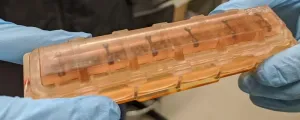(Press-News.org) A probable crater stretching more than 370 miles, or 600 kilometers, across the heart of Australia could reshape our understanding of Earth’s geological history.
Researcher Daniel Connelly and Virginia Commonwealth University’s Arif Sikder, Ph.D., believe they have found evidence to support the existence of MAPCIS – the Massive Australian Precambrian-Cambrian Impact Structure -– which is a nonconcentric complex crater that could provide new insights into the geological and biological evolution of our planet.
“Working on the MAPCIS project has been an incredible journey,” said Sikder, an associate professor in the Center for Environmental Studies, a unit of VCU Life Sciences. “The data we’ve gathered offers a unique glimpse into the forces that have shaped our planet, and I’m excited about the future research this discovery will inspire.”
This month, Connelly will make a presentation in Anaheim, California, at Connects 2024, the Geological Society of America’s annual meeting. In August, he presented at the 37th International Geological Congress 2024 in Busan, South Korea. According to researchers, the impact occurred at the end of the Ediacaran period, within the Neoproterozoic Era, which spans from 1 billion to 538.8 million years ago.
Among the geological evidence they have uncovered to support the age, size and location of the impact are massive deposits of pseudotachylite breccia, or melt rock, near the crater center. The researchers found shocked minerals, including lonsdaleite, or shocked diamond, in the deposits, along with impact level amounts of iridium.
“The discovery of MAPCIS is a testament to the power of collaborative research,” Connelly said. “Our findings not only highlight the significance of this impact structure but also open new avenues for understanding Earth’s geological past.”
END
Australian crater could offer fresh insight into Earth’s geological history
VCU’s Arif Sikder of the Center for Environmental Studies is part of the research team that is going back in time – by hundreds of millions of years.
2024-09-23
ELSE PRESS RELEASES FROM THIS DATE:
New study raises questions about validity of standard model of solar flares
2024-09-23
Solar flares are extremely intense events that occur in the Sun’s atmosphere, lasting anywhere from a few minutes to several hours. According to the standard flare model, the energy that triggers these explosions is transported by accelerated electrons that hurtle from the magnetic reconnection region in the corona to the chromosphere. As the electrons collide with the chromospheric plasma, they deposit their energy in the plasma, which is heated and ionized as a result. They also cause intense radiation in several ...
Paving the way for new treatments
2024-09-23
A University of Missouri researcher has created a computer program that can unravel the mysteries of how proteins work together — giving scientists valuable insights to better prevent, diagnose and treat cancer and other diseases.
Jianlin “Jack” Cheng from Mizzou’s College of Engineering and his student, Nabin Giri, have developed a tool called Cryo2Struct that uses artificial intelligence (AI) to build the three-dimensional atomic structure of large protein complexes, work recently published in Nature Communications. ...
Dream discovery: Melatonin's key role in REM sleep revealed
2024-09-23
A significant breakthrough in the understanding of sleep mechanism opens new promise for treating sleep disorders and associated neuropsychiatric conditions: Scientists have pinpointed the melatonin receptor MT1 as a crucial regulator of REM (Rapid Eye Movement) sleep.
REM sleep is crucial for dreaming, memory consolidation, and emotional regulation. In the brain, the melatonin MT1 receptor affects a type of neuron that synthesizes the neurotransmitter and hormone noradrenaline, found in an ...
Research quantifying “nociception” could help improve management of surgical pain
2024-09-23
The degree to which a surgical patient’s subconscious processing of pain, or “nociception,” is properly managed by their anesthesiologist will directly affect the degree of post-operative drug side effects they’ll experience and the need for further pain management they’ll require. But pain is a subjective feeling to measure, even when patients are awake, much less when they are unconscious. In a new study, MIT and Massachusetts General Hospital (MGH) researchers describe a set of statistical models that objectively quantified nociception during surgery. Ultimately, they hope to help anesthesiologists optimize drug dose and minimize post-operative ...
How cranes navigate their complex world
2024-09-23
The researchers used tiny GPS tracking devices to follow the movements of 104 cranes in Africa, Asia, and Europe. These devices included unique solar-powered GPS leg bands developed by scientists from MPI-AB. The tracking data revealed the impressive migrations that cranes undertook. Some of the migratory routes exceeded 6,400 km of travel round trip and required crossing barriers such as the Alps or Himalaya mountain ranges, the deserts of the Arabian peninsula, or the Mediterranean Sea. In addition to the tracking study, the researchers also developed a statistical framework that revealed how the cranes’ movements relate to aspects of the ...
New origami-inspired system turns flat-pack tubes into strong building materials
2024-09-23
Engineers at RMIT University have designed an innovative tubular structural system that can be packed flat for easier transport and pop up into strong building materials.
This breakthrough is made possible by a self-locking system inspired by curved-crease origami — a technique that uses curved crease lines in paper folding.
Lead researchers, Dr Jeff (Ting-Uei) Lee and Distinguished Professor Mike (Yi Min) Xie, said bamboo, which has internal structures providing natural reinforcement, inspired the tube design.
“This self-locking system is the result of an intelligent geometric design,” said Lee from RMIT’s School of Engineering. ...
Low gravity in space travel found to weaken and disrupt normal rhythm in heart muscle cells
2024-09-23
Johns Hopkins Medicine scientists who arranged for 48 human bioengineered heart tissue samples to spend 30 days at the International Space Station report evidence that the low gravity conditions in space weakened the tissues and disrupted their normal rhythmic beats when compared to earth-bound samples from the same source.
The scientists said the heart tissues “really don’t fare well in space,” and over time, the tissues aboard the space station beat about half as strong as tissues from the same source kept on Earth.
The findings, ...
New approach to defibrillation may improve cardiac arrest outcomes
2024-09-23
Joshua Lupton, M.D., has no memory of his own cardiac arrest in 2016. He only knows that first responders resuscitated his heart with a shock from a defibrillator, ultimately leading to his complete recovery and putting him among fewer than one in 10 people nationwide who survive cardiac arrest outside of a hospital.
He attributes his survival to the rapid defibrillation he received from first responders — but not everybody is so fortunate.
Now, as lead author on a new observational study published in the journal JAMA Network Open, he and co-authors from Oregon Health & Science University ...
UTA undergraduate researcher wins state honor
2024-09-23
A student studying biological chemistry at The University of Texas at Arlington earned a state-wide award for her research on diazo compounds, the building blocks of some medications. Jenny Hoang, a senior, received the third-place award at the 2024 University of Texas System Louis Stokes Alliance for Minority Participation (LSAMP) conference held in El Paso in August.
“Honestly, I was so shocked that I won third place because I almost didn’t even apply for this program,” said Hoang, a Carrollton ...
Novel method detects biological oxidant derived from CO2 in cells
2024-09-23
High levels of carbon dioxide (CO2) in the atmosphere can alter not only the climate of our planet but also the functioning of our cells. The gas interacts with hydrogen peroxide (H2O2), which performs various functions in the human body, giving rise to a potent oxidant called peroxymonocarbonate.
"More and more evidence is emerging that peroxymonocarbonate is important in both cells’ adaptive responses via redox signaling and in cellular dysfunction. There is also epidemiological evidence that the levels of CO2 our cities are close to reaching cause a number of physiological problems. And the mechanisms underlying the toxicity of CO2 are ...
LAST 30 PRESS RELEASES:
Decoupling the HOR enhancement on PtRu: Dynamically matching interfacial water to reaction coordinates
Sulfur isn’t poisonous when it synergistically acts with phosphine in olefins hydroformylation
URI researchers uncover molecular mechanisms behind speciation in corals
Chitin based carbon aerogel offers a cleaner way to store thermal energy
Tracing hidden sources of nitrate pollution in rapidly changing rural urban landscapes
Viruses on plastic pollution may quietly accelerate the spread of antibiotic resistance
Three UH Rainbow Babies & Children’s faculty elected to prestigious American Pediatric Society
Tunnel resilience models unveiled to aid post-earthquake recovery
Satellite communication systems: the future of 5G/6G connectivity
Space computing power networks: a new frontier for satellite technologies
Experiments advance potential of protein that makes hydrogen sulfide as a therapeutic target for Alzheimer’s disease
Examining private equity’s role in fertility care
Current Molecular Pharmacology achieves a landmark: real-time CiteScore advances to 7.2
Skeletal muscle epigenetic clocks developed using postmortem tissue from an Asian population
Estimating unemployment rates with social media data
Climate policies can backfire by eroding “green” values, study finds
Too much screen time too soon? A*STAR study links infant screen exposure to brain changes and teen anxiety
Global psychiatry mourns Professor Dan Stein, visionary who transformed mental health science across Africa and beyond
KIST develops eco-friendly palladium recovery technology to safeguard resource security
Statins significantly reduce mortality risk for adults with diabetes, regardless of cardiovascular risk
Brain immune cells may drive more damage in females than males with Alzheimer’s
Evidence-based recommendations empower clinicians to manage epilepsy in pregnancy
Fungus turns bark beetles’ defenses against them
There are new antivirals being tested for herpesviruses. Scientists now know how they work
CDI scientist, colleagues author review of global burden of fungus Candida auris
How does stroke influence speech comprehension?
B cells transiently unlock their plasticity, risking lymphoma development
Advanced AI dodel predicts spoken language outcomes in deaf children after cochlear implants
Multimodal imaging-based cerebral blood flow prediction model development in simulated microgravity
Accelerated streaming subgraph matching framework is faster, more robust, and scalable
[Press-News.org] Australian crater could offer fresh insight into Earth’s geological historyVCU’s Arif Sikder of the Center for Environmental Studies is part of the research team that is going back in time – by hundreds of millions of years.






